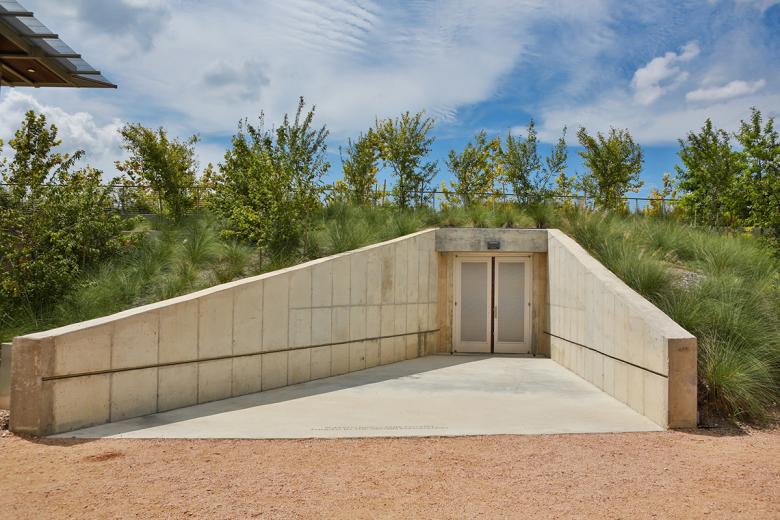US Building of the Week
The Cistern
Buffalo Bayou Park consists of waterfront parks, bike trails, pedestrian bridges, and other features that make it a Houston destination. The Cistern is a found treasure that sits within the park and gives people another reason to visit. Transformed subtly yet dramatically by Page (Page Southerland Page, Inc.), a once-industrial piece of infrastructure is now publicly accessible. The architects answered a few questions about the project.
Location: Houston, Texas, USA
Client: Buffalo Bayou Partnership
Architect: Page (Page Southerland Page, Inc.)
Design Principal: Lawrence Speck, FAIA
Project Architect: Melanie Starman Bash, AIA
Project Manager: Randolph L. Hurst
Mechanical Engineer: Page (Page Southerland Page, Inc.); Garrett Neubauer, PE; Luis Reyes, PE
Structural Engineer: RDP Engineers, Inc.
Electrical Engineer: Hunt and Hunt Engineering Corp
Landscape Architect: SWA Group
Civil Engineer: United Engineers, Inc.
Survey: AECOM Technical Services, Inc.
Contractor: Millis Development & Construction, Inc.
Lighting: Neutex (Interior); Dual-Lite (Exterior)
Railings: Pool Custom Ironworks; JEF Fabrication, Inc.
Photographs: Albert Vecerka/Esto
What were the circumstances of receiving the commission for this project?
Originally constructed in 1926 as Houston’s first underground drinking water reservoir, the Cistern sprang an irreparable leak and was decommissioned in 2007. By the time that the Buffalo Bayou Partnership rediscovered the subterranean structure in 2011, the City of Houston had already solicited bids for its demolition and was considering commercial uses for the site. Recognizing its value as an architectural treasure and artifact of the city’s history, the Partnership worked with the City to take over management of the site and enlisted the design team of Page and SWA Group to repurpose the reservoir as a dramatic civic space.
Please provide an overview of the project.
Spanning 87,500 square feet — 1.5 football fields — The Cistern is a monumental piece of infrastructure transformed into a unique civic landmark. Its 221 slender columns with belled capitals and squared bases support massive 8-inch thickened slab roof system. The reservoir also boasts impressive acoustics, with a 17-second reverberation that elevates sound to that of a physical material.
What are the main ideas and inspirations influencing the project's design?
On a cold winter day in 2011, the design team dropped through the reservoir’s existing rooftop hatch into a into a raw and extraordinary space. They were struck by the similarities of this 20th-century industrial space to the ancient Roman cisterns beneath Istanbul and nicknamed it The Cistern. The designers’ initial experience was one of surprise, mystery and suspense. Their challenge was to reprogram the space, bring it up to code, and make it accessible and inviting to the public, while carefully preserving its original architectural character.
The Cistern’s unique light and sound qualities inspired the project team to transform the reservoir into a venue for environmental art installations that emphasizes these unique qualities. Improvements to the space are simple and limited, so to focus the visitor experience on the rhythm of the columns, their reflections in the water, and the magnification of sound. A new catwalk with delicate handrail lines the space, allowing visitors to fully appreciate its scale. Reflections of the columns in the water create the illusion of a double-height space.
How does the design respond to the unique qualities of the site?
To preserve an element of surprise, a berm conceals The Cistern’s perimeter walls, so it blends into the landscape. A new entrance at grade initiates a gradual transition between the sunlight and activity of Buffalo Bayou Park and the saturated darkness of the interior. An 800-square-foot tunnel cuts a winding path through the berm that negotiates the change in grade, allows visitors’ eyes to adjust to low light levels and builds suspense by concealing views of The Cistern’s interior. A ribbon of soft LED light illuminates the walkway and highlights the texture of board-formed concrete walls, which mimic the original construction method of The Cistern.
Was the project influenced by any trends in energy-conservation, construction, or design?
The Cistern exemplifies Houston’s relatively recent commitment to preserving its architectural history, as well as the potential of adaptive reuse to transform defunct spaces into create unique civic destinations. Since it opened in May 2016, The Cistern has received over 66,000 visitors from countries all over the world. Its first exhibition, Rain, by multimedia artist Magdalena Fernandez, drew an audience of nearly 35,000 to appreciate The Cistern’s unique light and sound qualities.
The Cistern was never intended for sustained human exposure, so new systems were necessary to ensure visitors’ comfort and safety. Four exit doors now punctuate the exterior berms to create fire egress. A new mechanical system threads into the structure to provide adequate ventilation, indoor air quality, consistent temperature and humidity. The water on the floor is recirculated through a duplex sump pump system that contains two sand filters, which eliminates the need for chemical detergents. This technology is essential, since The Cistern is still connected to the original storm system that links to the city’s largest natural waterway, which drains to the Gulf of Mexico.
Email interview conducted by John Hill.









